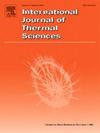Experimental study of a single-phase immersion cooling system with natural and forced convection
IF 4.9
2区 工程技术
Q1 ENGINEERING, MECHANICAL
International Journal of Thermal Sciences
Pub Date : 2025-03-20
DOI:10.1016/j.ijthermalsci.2025.109868
引用次数: 0
Abstract
The rapid advancement of the electronics industry has led to the emergence of miniaturized, high-speed devices with significant amount of volumetric heat generation. Immersion cooling systems offer an effective solution for managing high heat loads, particularly in data centers and battery thermal management systems. However, several fundamental issues of the underlying physical phenomena still need to be addressed to improve the efficiency of these systems. In this study, an immersion cooling system using Novec 7100 dielectric liquid has been experimentally investigated having four electric cartridge heaters with circular and square cross-sections. The effect of distance between heaters on the surface temperature was analyzed under different flow conditions. Furthermore, the effect of heater cross-section on the heat transfer coefficient was examined. For natural convection, the heat transfer coefficient increased as the distance between the heaters was increased for both heaters. As expected, the forced convection mechanism was found to be significantly more effective in heat removal compared to natural convection. At high heat flux values, the heat transfer coefficient was found to be higher for square heaters due to their 1.15 times larger surface area. However, for low heat flux values, the heat transfer coefficient was higher for circular heaters than the square heaters. These findings provide valuable insights into the optimization of immersion cooling systems, highlighting the influence of heater geometry and heater spacing on thermal management efficiency.
求助全文
约1分钟内获得全文
求助全文
来源期刊

International Journal of Thermal Sciences
工程技术-工程:机械
CiteScore
8.10
自引率
11.10%
发文量
531
审稿时长
55 days
期刊介绍:
The International Journal of Thermal Sciences is a journal devoted to the publication of fundamental studies on the physics of transfer processes in general, with an emphasis on thermal aspects and also applied research on various processes, energy systems and the environment. Articles are published in English and French, and are subject to peer review.
The fundamental subjects considered within the scope of the journal are:
* Heat and relevant mass transfer at all scales (nano, micro and macro) and in all types of material (heterogeneous, composites, biological,...) and fluid flow
* Forced, natural or mixed convection in reactive or non-reactive media
* Single or multi–phase fluid flow with or without phase change
* Near–and far–field radiative heat transfer
* Combined modes of heat transfer in complex systems (for example, plasmas, biological, geological,...)
* Multiscale modelling
The applied research topics include:
* Heat exchangers, heat pipes, cooling processes
* Transport phenomena taking place in industrial processes (chemical, food and agricultural, metallurgical, space and aeronautical, automobile industries)
* Nano–and micro–technology for energy, space, biosystems and devices
* Heat transport analysis in advanced systems
* Impact of energy–related processes on environment, and emerging energy systems
The study of thermophysical properties of materials and fluids, thermal measurement techniques, inverse methods, and the developments of experimental methods are within the scope of the International Journal of Thermal Sciences which also covers the modelling, and numerical methods applied to thermal transfer.
 求助内容:
求助内容: 应助结果提醒方式:
应助结果提醒方式:


